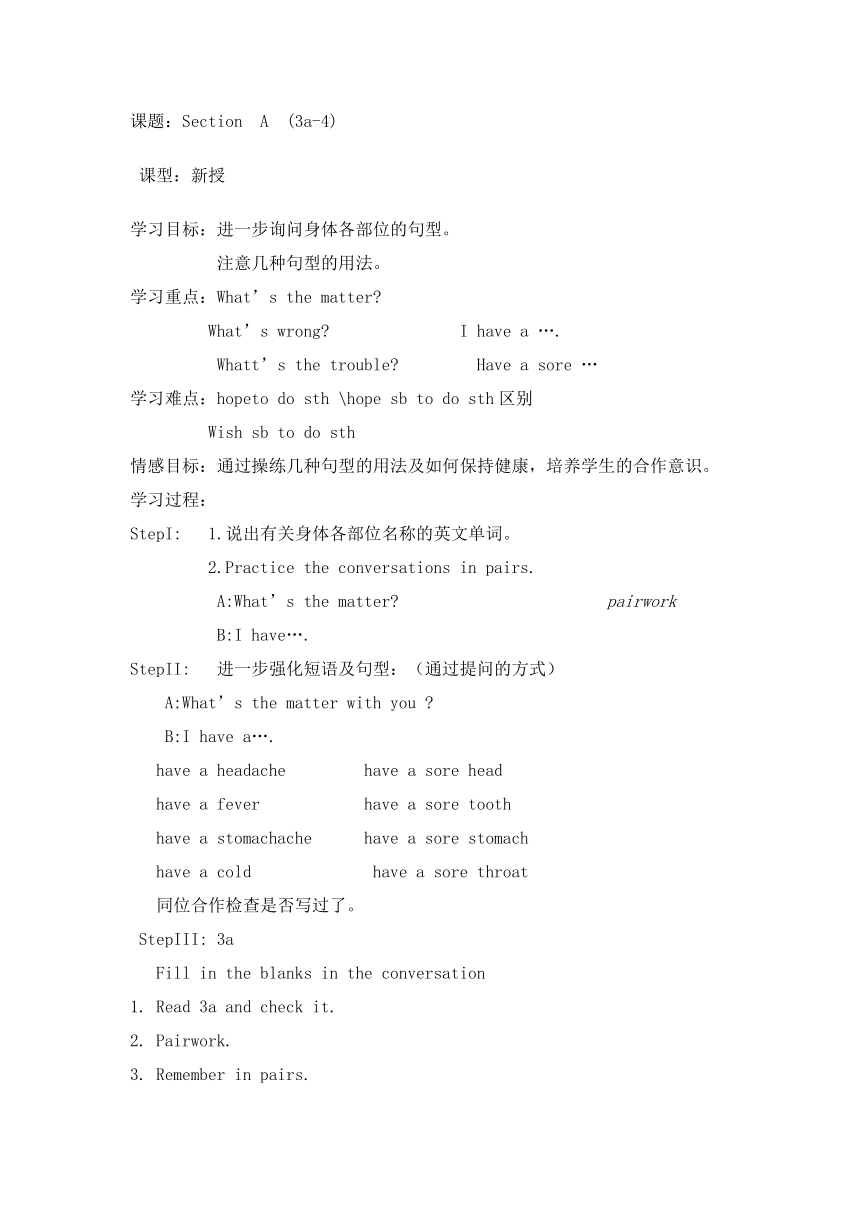Unit2 What’s the matter? Section A (3a-4).
文档属性
| 名称 | Unit2 What’s the matter? Section A (3a-4). |

|
|
| 格式 | zip | ||
| 文件大小 | 12.7KB | ||
| 资源类型 | 教案 | ||
| 版本资源 | 人教新目标(Go for it)版 | ||
| 科目 | 英语 | ||
| 更新时间 | 2011-09-19 14:04:51 | ||
图片预览

文档简介
课题:Section A (3a-4)
课型:新授
学习目标:进一步询问身体各部位的句型。
注意几种句型的用法。
学习重点:What’s the matter
What’s wrong I have a ….
Whatt’s the trouble Have a sore …
学习难点:hopeto do sth \hope sb to do sth区别
Wish sb to do sth
情感目标:通过操练几种句型的用法及如何保持健康,培养学生的合作意识。
学习过程:
StepI: 1.说出有关身体各部位名称的英文单词。
2.Practice the conversations in pairs.
A:What’s the matter pairwork
B:I have….
StepII: 进一步强化短语及句型:(通过提问的方式)
A:What’s the matter with you
B:I have a….
have a headache have a sore head
have a fever have a sore tooth
have a stomachache have a sore stomach
have a cold have a sore throat
同位合作检查是否写过了。
StepIII: 3a
Fill in the blanks in the conversation
Read 3a and check it.
Pairwork.
Remember in pairs.
点拨:hope to do sth 希望做某事
hope+宾语从句
wish sb to do sth 希望某人做某事
feel系动词
feel weel 感觉好
StepIV:小结
可以用What’s the matter 也可以用What’s wrong 如果询问某人用with连接。例如:
Tom怎么了?What’s the matter with Tom 或 What’s wrong with Tom
2. 英语中表示疾病的名词或名词词组,大多可以采取两种方式构成,看下面的表格,你能找出规律吗?
A B
head→headache back→sore back
tooth→toothache throat→sore throat
stomach→stomachache eye→ sore eye
A:__________________﹢ __________________
B:__________________ + ___________________
Answers: A: 身体部位名词﹢-ache后缀 B: 前置形容词sore﹢身体部位名词 3. should是情态动词,具有情态动词的一切用法。
StepV. Work in groups of six. Suppose you are a doctor in a clinic(诊所),the others are patients.
Make a survey to fill in the chart.
Name Illness(疾病) Advice(建议)
Tom Have a fever Have lots of water
参考句型:A: What’s the matter (with you)
B: I have a fever.
A: You should drink lots of water.
B: Thank you.
Task2. Give a report and then write it down like this: Tom has a fever. He should drink lots of water. …
V. Summary Task1. Sum up how to talk about health and give advice. 1)怎样询问:______________________ 或 ________________________________? 2)怎样回答:_____________________________/ ________________________________ 3)给出建议:________________________________________________________
Task2. Do the following exercises.
1) What’s wrong with you (同义句)_________________________________
2) I have a sore throat. (对划线部分提问)_______________________
3) You should eat something.(改为否定句)__________________________
4) Tom should see a dentist. (对划线部分提问)_______________________ StepVI. Homework
Task1. Review this lesson and finish the exercises in Tongbu.
Task2. Preview 3a-4.
课型:新授
学习目标:进一步询问身体各部位的句型。
注意几种句型的用法。
学习重点:What’s the matter
What’s wrong I have a ….
Whatt’s the trouble Have a sore …
学习难点:hopeto do sth \hope sb to do sth区别
Wish sb to do sth
情感目标:通过操练几种句型的用法及如何保持健康,培养学生的合作意识。
学习过程:
StepI: 1.说出有关身体各部位名称的英文单词。
2.Practice the conversations in pairs.
A:What’s the matter pairwork
B:I have….
StepII: 进一步强化短语及句型:(通过提问的方式)
A:What’s the matter with you
B:I have a….
have a headache have a sore head
have a fever have a sore tooth
have a stomachache have a sore stomach
have a cold have a sore throat
同位合作检查是否写过了。
StepIII: 3a
Fill in the blanks in the conversation
Read 3a and check it.
Pairwork.
Remember in pairs.
点拨:hope to do sth 希望做某事
hope+宾语从句
wish sb to do sth 希望某人做某事
feel系动词
feel weel 感觉好
StepIV:小结
可以用What’s the matter 也可以用What’s wrong 如果询问某人用with连接。例如:
Tom怎么了?What’s the matter with Tom 或 What’s wrong with Tom
2. 英语中表示疾病的名词或名词词组,大多可以采取两种方式构成,看下面的表格,你能找出规律吗?
A B
head→headache back→sore back
tooth→toothache throat→sore throat
stomach→stomachache eye→ sore eye
A:__________________﹢ __________________
B:__________________ + ___________________
Answers: A: 身体部位名词﹢-ache后缀 B: 前置形容词sore﹢身体部位名词 3. should是情态动词,具有情态动词的一切用法。
StepV. Work in groups of six. Suppose you are a doctor in a clinic(诊所),the others are patients.
Make a survey to fill in the chart.
Name Illness(疾病) Advice(建议)
Tom Have a fever Have lots of water
参考句型:A: What’s the matter (with you)
B: I have a fever.
A: You should drink lots of water.
B: Thank you.
Task2. Give a report and then write it down like this: Tom has a fever. He should drink lots of water. …
V. Summary Task1. Sum up how to talk about health and give advice. 1)怎样询问:______________________ 或 ________________________________? 2)怎样回答:_____________________________/ ________________________________ 3)给出建议:________________________________________________________
Task2. Do the following exercises.
1) What’s wrong with you (同义句)_________________________________
2) I have a sore throat. (对划线部分提问)_______________________
3) You should eat something.(改为否定句)__________________________
4) Tom should see a dentist. (对划线部分提问)_______________________ StepVI. Homework
Task1. Review this lesson and finish the exercises in Tongbu.
Task2. Preview 3a-4.
同课章节目录
- Unit 1 What's the matter?
- Section A
- Section B
- Unit 2 I'll help to clean up the city parks.
- Section A
- Section B
- Unit 3 Could you please clean your room?
- Section A
- Section B
- Unit 4 Why don't you talk to your parents?
- Section A
- Section B
- Unit 5 What were you doing when the rainstorm came
- Section A
- Section B
- Review of Units 1-5
- Unit 6 An old man tried to move the mountains.
- Section A
- Section B
- Unit 7 What's the highest mountain in the world?
- Section A
- Section B
- Unit 8 Have you read Treasure Island yet?
- Section A
- Section B
- Unit 9 Have you ever been to a museum?
- Section A
- Section B
- Unit 10 I've had this bike for three years.
- Section A
- Section B
